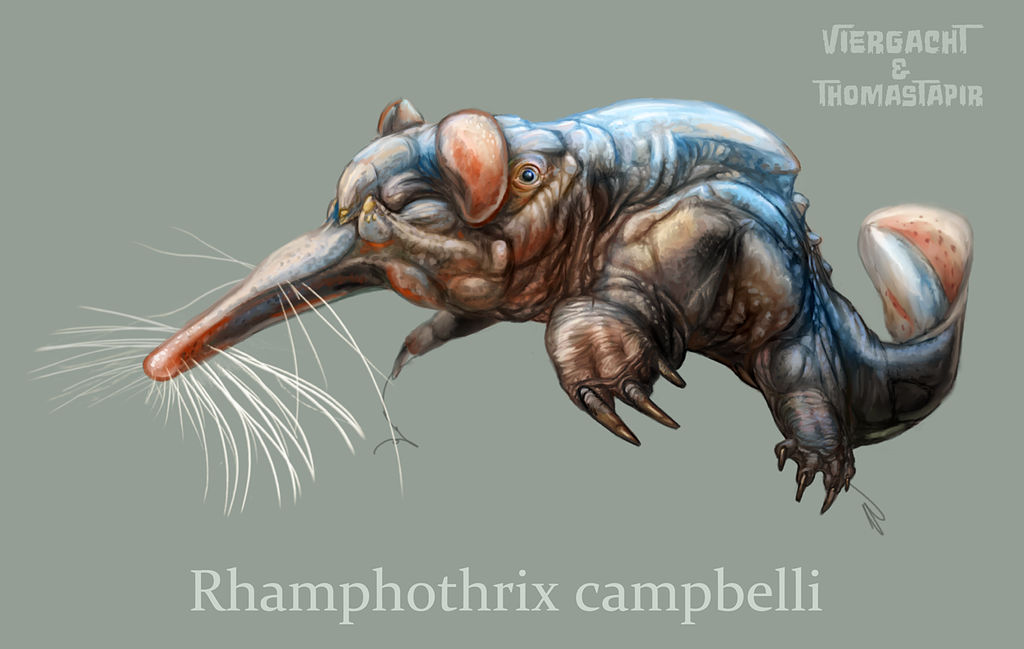Deviation Actions
Description
:origin()/pre10/a152/th/pre/f/2015/198/7/9/felicetacean_by_thomastapir-d91rdom.jpg)
Rhamphothrix campbelli (Campbell's hairy beak)
A person from this time would be hard-pressed to see anything similar to the cat purring in their lap, but the Thrix is indeed a feline, one of the most derived members of the felicetaceans.
It seems odd that aquatic creatures would thrive in the widespread droughts that characterized the mass extinctions at the end of the Anthropocene. However, the jaguarondi (Puma yagouaroundi) exploited its swimming abilities to lurk in the rare watering holes, springing out on prey animals that were obliged to drink there, and over time developed into the large, sleek, otter-like "lake lions" or "river cats" (Gyrinopuma spp.).
The Thrix retains the basic form of a river cat, but has adapted to the chilly, turbulent waters of the high northern mountain creeks. Although they can swim, with their paddle shaped tails, Thrix usually clamber over and cling to rocks at the bottom with their powerful clawed limbs. They are capable of holding their breath an extraordinarily long time.
Thrix typically prey on crawling-hand crabs and creek leeches, using their distinctive long chin armed with stiff vibrissae to prod into the rocks and mud, detecting the slightest movements. In their noisy, silty environment, sight and hearing do very little so the Thrix has reduced ears that are barely more than slits on the side of the head, and small, weak eyes that are mostly used to detect the shadows of predators looming overhead. The large bony pads jutting from the front of the eyes protect them from the claws and teeth of their prey.
Thrix descend from the Guldurgu swamp sabre cats, which shed their coats for a thick, leathery skin and evolved a large flange on their chin which acted as a sheath for sabre teeth, similar to the extinct marsupial Thylacosmilus. Thrix no longer have sabres, and in fact hardly have any teeth at all, instead using a hard, turtle-like ridge on their gums to crush prey. It's thought that the loss of teeth is genetically correlated with the loss of a pelt. The Thrix does have several denticles on the jaw which serve in place of teeth, however.
A Thrix's stout, solidly-built body is coated in a thick layer of blubber-like fat, which keeps it warm and serves as a back-up food store. Both sexes have humps of fat on the back, which also protect the spine from their main predator, the snaggle-beaked fishing eagle. Males sport a particularly large hump shaped a bit like a shark's fin, which not only makes it visually and by disturbance of currents from a female but advertises its fitness and suitability as a mate – a male with a big, firmly-filled hump is clearly a better hunter.
Each Thrix patrols a territory that consists of s stretch of creek, of which it learns every nook and cranny over its fifteen to twenty year lifespan, and which it defends vigorously from intruders. Generally females live in the higher elevations, and males in the lower. When a female comes into heat, her pheromones wash downstream and attract a swarm of males who travel up to court her, fighting each other along the way. Breeding usually occurs during the early spring, when water levels are at their highest and the creeks are fast and cold due to the ice melt.
Gravid females create natal pool by digging a hole off to the side of the main creek and letting it fill with groundwater. These pools are warmer and stagnant, perfect for kittens learning to swim. She then digs a burrow far above the waterline. After a three-month gestation, females give birth to a litter of anywhere from one to seven kittens, with four being a typical litter size. The kittens have a coat of thick, wooly fur which is not waterproof, and stay in the den for their first four weeks. As their fur sheds out, the kittens begin swimming in the natal pool, and by high summer, three months later, are weaned and ready to swim off on their own.
Pristichampsus also did a version - interesting to see how they're the same and how they differ:
:origin()/pre02/877c/th/pre/f/2015/204/0/2/thomastapir_s_felicetacean_by_pristichampsus-d92gnc1.jpg)






































